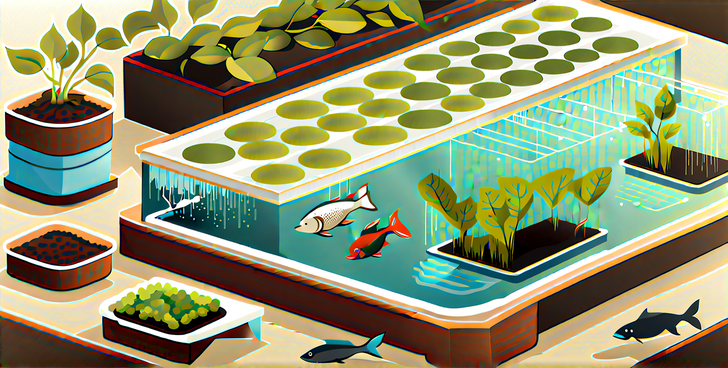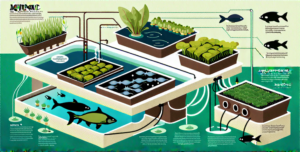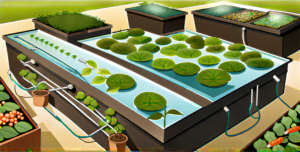Future of Aquaponics: Aquaponics is gaining attention from industry stakeholders and consumers as the world moves toward sustainable food production. Aquaponics, which combines aquaculture and hydroponics, has grown from the fringe to the mainstream of agricultural discourse due to promising market trends.
Aquaponics: Sustainable Farming
Aquaponics represents circular agriculture and eco-efficient farming. Hydroponic plant cultivation and aquaculture create a closed-loop system that reduces waste, conserves water, and uses no synthetic fertilizers.
Aquaponics
Define and Explain
Aquaponics is a sustainable and innovative farming method that combines aquaculture (raising aquatic animals) and hydroponics (growing plants without soil). In a balanced, symbiotic ecosystem, this method benefits plants and aquatic life.
Aquaponic System Parts
Aquaponics has three main components: aquaculture for raising aquatic animals, hydroponics for growing plants, and a biofilter with bacteria that detoxify waste for plant uptake.
How does aquaponics work?
Fish-Plant Symbiosis
In aquaponics, bacteria convert fish waste into nitrates, a nutrient-rich plant food. The plants absorb these nitrates, purifying the water for fish growth.
Nutrient Cycling Bacteria
Aquaponics bacteria start nitrification. They metabolize fish waste into ammonia, nitrites, and nitrates, creating a non-toxic environment for aquatic and plant life.
Aquaponics Market Status
Market size and growth
Aquaponics Statistics
Recent studies predict that climate change, water scarcity, and the global push for sustainable farming will boost the aquaponics market.
Growth Drivers
Rapid urbanization, growing demand for organic produce, and awareness of sustainable farming have helped the aquaponics industry grow.
Regional analysis
North American Aquaponics Market and Growth Potential
The US leads the global aquaponics market. Technological advances, a mature market, and consumer awareness of sustainable farming drove the region’s growth.
Leaders and Innovations
Nelson & Pade Inc. and Backyard Aquaponics are leading North American aquaponic innovation.
Europe
European Market Trends
Aquaponics is growing in Europe due to government support and consumer demand for organic food.
Regulations and Government Support
Aquaponics has flourished under EU policies that promote sustainable farming.
Asia-Pacific Aquaponics Adoption
Commercial urban farming in Japan, China, and Australia is fueling the growth of aquaponics in the Asia Pacific.
Major Markets and Challenges
This region has many opportunities, but challenges remain. These include technological inaccessibility, high initial investment costs, and skilled labor.
Aquaponics Abroad
Sustainable farming may boost aquaponics development in Latin America, the Middle East, and Africa.
Markets and Barriers
Despite a promising outlook, market entry barriers like lack of technology, climate, and infrastructure exist.
New Tech
Vertical farming/aquaponics
Vertical Aquaponic Systems Benefits
Vertical aquaponic systems solve urban space issues by allowing high-density, high-yield production while retaining aquaponics’ benefits.
Technology Boosting Vertical Farming
Vertical aquaponic farming has grown due to LED lighting, automation, and climate control advances.
Aquaponics IoT
IoT in Aquaponic System Monitoring and Automation
Modern aquaponics relies on the IoT to automate feeding, water exchange, and pH, temperature, and nutrient monitoring.
IoT integration improves productivity and reduces labor costs. Cybersecurity and implementation costs are obstacles.
Aquaponics AI
Aquaponics AI Applications
AI can manage aquaponic systems through machine learning and predictive analytics. It optimizes nutrient balance, prevents disease, and predicts yield, increasing productivity.
AI-Powered Predictive Analytics
Aquaponic farming can be smarter and more responsive with AI-powered decision-making tools.
Market Opportunities
Commercial aquaponics
Commercial Aquaponic Farms Grow Technology and demand for organic produce are driving commercial-scale aquaponics operations.
Market Potential
In water-scarce or soil-poor areas, commercial aquaponics offers investors, farmers, and entrepreneurs opportunities.
Urban aquaponics
Urban Agriculture: Aquaponics
Aquaponics helps city dwellers grow their own food, reduce carbon footprint, and support local food systems.
Local Food and Micro-Farming
Urban aquaponics promotes food security and community resilience through micro-farming and hyper-local food production.
Smart City Integration
Sustainable Urban Aquaponics
Sustainable smart cities can use aquaponics to turn urban spaces into productive green spaces and promote local, circular economies.
Architects and Urban Planners
Aquaponics can improve city livability and sustainability when urban planners and architects work together.
Ecological Impact
Resource efficiency
Water conservation and footprint reduction
Aquaponics systems use 90% less water and no synthetic fertilizers or pesticides, reducing their environmental impact.
Efficiency and Renewable Energy Integration
Renewable energy can boost aquaponics systems’ sustainability.
Closed-loop systems
Circular Economy and Closed-Loop Aquaponics
Aquaponics is a closed-loop system where waste is a resource, following circular economy principles.
Nutrient Cycling and Waste Reduction
Aquaponics nutrient cycling reduces waste, pollution, and ecosystem imbalance.
Climate resilience
Climate-Adaptive Aquaponics
Aquaponics is a climate-resilient farming method because it conserves water and works regardless of soil and climate.
Extreme Weather Mitigation
Aquaponics can withstand extreme weather and climate change because it doesn’t need rain.
Challenges and Prospects
Technical Issues
System complexity and upkeep
Aquaponics systems require technical expertise to set up and maintain, despite their benefits.
Healthcare and Biosecurity
Maintaining system health and disease management in closed systems is difficult.
Profitability
Cost and ROI
Aquaponics systems are expensive to set up, and profitability depends on market demand, scale, and input costs.
Competition and Prices
Aquaponics’ competitiveness depends on consumers’ willingness to pay more for sustainably grown products, given organic produce’s higher cost.
Consumer Education
Consumers’ Aquaponics Knowledge
Aquaponics’ growth depends on consumer acceptance. Misperceptions may hinder market penetration.
Educating and Reaching
Aquaponics market growth and acceptance depend on consumer education and outreach.
Conclusion of The Future of Aquaponics Predicted Market Trends
Aquaponics Market Forecast
Aquaponics is promising. Technological advances, market trends, and consumer preferences will drive the sector’s growth as global trends toward sustainability and local food production grow.
Aquaponics’ Sustainable Agriculture Future
Aquaponics is a sustainable solution to some of the world’s biggest food production and environmental issues. This innovative farming method has untapped potential and a bright future.
FAQs
Q1 What is driving the growing popularity of aquaponics?
Ans: Increasing awareness about sustainable farming, coupled with the rising demand for organic produce, is fueling the growing popularity of aquaponics globally.
Q2 What role do emerging technologies like AI and IoT play in aquaponics?
Ans: Emerging technologies such as AI and IoT enhance aquaponic system management through real-time monitoring, predictive analytics, and automation, boosting efficiency and productivity.
Q3 How is aquaponics contributing to urban agriculture and smart city development?
Ans: Aquaponics offers a viable solution for urban agriculture by turning limited city spaces into productive green areas, while also playing a key role in the sustainable development of smart cities.
Q4 Why is aquaponics considered a climate-resilient farming method?
Ans: Aquaponics is considered climate-resilient as it conserves water, operates independently of soil quality and climate conditions, and is resilient to extreme weather events and changing climate conditions.
Q5 What challenges does the aquaponics industry face in terms of economic viability?
Ans: Initial setup costs, variability in profitability, and the competitiveness of the market, largely depending on consumer willingness to pay a premium for sustainably grown products, pose economic challenges for the aquaponics industry.
Our Reader’s Queries
Are aquaponics the future?
Aquaponics, a combination of vegetable and fish farming, is gaining popularity as a sustainable method of agriculture. There are various subtypes of aquaponics, including the low maintenance deep water variety and space-efficient vertical farming. This innovative approach to farming is being touted as the future of agriculture due to its ability to produce high yields of fresh produce and fish while using less water and land than traditional farming methods.
What is the new technology in aquaponics?
Media-based aquaponics systems are a revolutionary farming technology that involves flooding plant media with a drainage channel connected to a fish tank. This innovative system allows for the growth of various soil-based vegetables in a soilless medium. With this method, farmers can produce high-quality crops while conserving water and reducing waste. It’s a sustainable and efficient way to grow food that’s gaining popularity around the world.
What is the market outlook for aquaponics?
The Aquaponics industry is projected to experience a significant growth rate of 12.10% between 2023 and 2033. The market is currently valued at USD 863.94 Million in 2023.
Why is aquaponics not profitable?
Aquaponics yields lower vegetable output and smaller fish revenue in non-organic systems compared to hydroponics. Additionally, costs and investments are higher in this setup. To optimize results, it is recommended to use organic methods in aquaponics.



